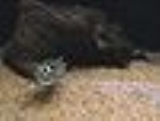
Tetraodon nigroviridis
Encyclopedia
Tetraodon nigroviridis is one of the pufferfish
known as the green spotted puffer
. It is found across South
and Southeast Asia
in coastal freshwater
and brackish water habitats. Tetraodon nigroviridis reaches a maximum length of about 15 cm (5.9 in). In February 2009 it was successfully bred in captivity at University of Florida using a new variation of the ovarian lavage technique.
forests. This is however disputed and the exact habitat of this fish is not yet fully known. Diet consists primarily of snails, but includes small invertebrates such as mollusks, crustaceans, and some plant material. This species may also be lepidophagous
.
genome
, roughly 340 million base pairs, and has thus been selected as a model organism for genetics
. In 2004 a draft of its genome sequence was published.
and is very widely traded as an aquarium fish
, and is sometimes mistaken as the Ceylon Puffer, or Tetraodon fluviatilis. Tetraodon nigroviridis also has some degree of value as a lab animal, in particular in the field of genetics, because it has the same number of genes
as human beings but in a genome about one-tenth the size.
Pufferfish
Tetraodontidae is a family of primarily marine and estuarine fish of the Tetraodontiformes order. The family includes many familiar species which are variously called pufferfish, balloonfish, blowfish, bubblefish, globefish, swellfish, toadfish, toadies, honey toads, sugar toads, and sea squab...
known as the green spotted puffer
Green spotted puffer
A green spotted puffer may be one of several different species of fresh or brackish water pufferfish in the genus Tetraodon, including:*Tetraodon fluviatilis, sometimes called the Ceylon or topaz puffer*Tetraodon nigroviridis...
. It is found across South
South Asia
South Asia, also known as Southern Asia, is the southern region of the Asian continent, which comprises the sub-Himalayan countries and, for some authorities , also includes the adjoining countries to the west and the east...
and Southeast Asia
Southeast Asia
Southeast Asia, South-East Asia, South East Asia or Southeastern Asia is a subregion of Asia, consisting of the countries that are geographically south of China, east of India, west of New Guinea and north of Australia. The region lies on the intersection of geological plates, with heavy seismic...
in coastal freshwater
Freshwater
Fresh water is naturally occurring water on the Earth's surface in ice sheets, ice caps, glaciers, bogs, ponds, lakes, rivers and streams, and underground as groundwater in aquifers and underground streams. Fresh water is generally characterized by having low concentrations of dissolved salts and...
and brackish water habitats. Tetraodon nigroviridis reaches a maximum length of about 15 cm (5.9 in). In February 2009 it was successfully bred in captivity at University of Florida using a new variation of the ovarian lavage technique.
Ecology
Adult Tetraodon nigroviridis are found in freshwater streams, rivers, and flood plains; young are found in brackish water. It is also found in mangroveMangrove
Mangroves are various kinds of trees up to medium height and shrubs that grow in saline coastal sediment habitats in the tropics and subtropics – mainly between latitudes N and S...
forests. This is however disputed and the exact habitat of this fish is not yet fully known. Diet consists primarily of snails, but includes small invertebrates such as mollusks, crustaceans, and some plant material. This species may also be lepidophagous
Lepidophagy
Lepidophagy is a specialised feeding behaviour in fish that involves eating of scales of other fish. Lepidophagy is widespread, having been independently evolved in at least five freshwater families and seven marine families...
.
Genetics
Tetraodon nigroviridis has the smallest known vertebrateVertebrate
Vertebrates are animals that are members of the subphylum Vertebrata . Vertebrates are the largest group of chordates, with currently about 58,000 species described. Vertebrates include the jawless fishes, bony fishes, sharks and rays, amphibians, reptiles, mammals, and birds...
genome
Genome
In modern molecular biology and genetics, the genome is the entirety of an organism's hereditary information. It is encoded either in DNA or, for many types of virus, in RNA. The genome includes both the genes and the non-coding sequences of the DNA/RNA....
, roughly 340 million base pairs, and has thus been selected as a model organism for genetics
Genetics
Genetics , a discipline of biology, is the science of genes, heredity, and variation in living organisms....
. In 2004 a draft of its genome sequence was published.
Commercial importance
Tetraodon nigroviridis is by no means a food fish, but has some value as baitBait (luring substance)
Bait is any substance used to attract prey, e.g. in a mousetrap.-In Australia:Baiting in Australia refers to specific campaigns to control foxes, wild dogs and dingos by poisoning in areas where they are a problem...
and is very widely traded as an aquarium fish
Fishkeeping
Fishkeeping is a popular hobby concerned with keeping fish in a home aquarium or garden pond. There is also a fishkeeping industry, as a branch of agriculture.-Types of fishkeeping systems:...
, and is sometimes mistaken as the Ceylon Puffer, or Tetraodon fluviatilis. Tetraodon nigroviridis also has some degree of value as a lab animal, in particular in the field of genetics, because it has the same number of genes
Gênes
Gênes is the name of a département of the First French Empire in present Italy, named after the city of Genoa. It was formed in 1805, when Napoleon Bonaparte occupied the Republic of Genoa. Its capital was Genoa, and it was divided in the arrondissements of Genoa, Bobbio, Novi Ligure, Tortona and...
as human beings but in a genome about one-tenth the size.

